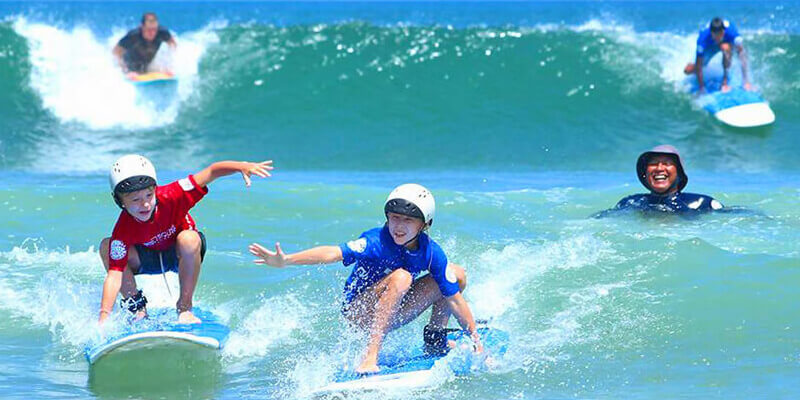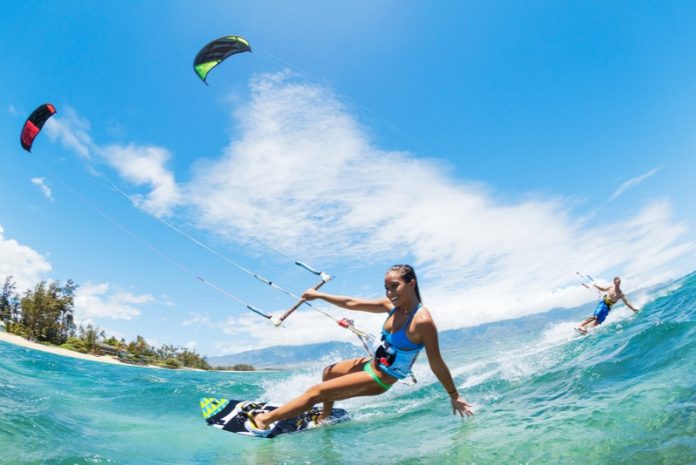Are you looking for an adrenaline-pumping water sport that will take you to new heights? Look no further than kiteboarding, where you can soar through the air and ride the waves for the ultimate thrill.
Kiteboarding, also known as kitesurfing, is a relatively new sport that combines aspects of surfing, wakeboarding, and parasailing. With a kite and board, you can harness the power of the wind to propel yourself across the water and perform impressive tricks in the air.
But before you dive into this extreme sport, it’s important to understand the history and evolution of kiteboarding, as well as the essential equipment and safety tips to ensure a successful and enjoyable experience.
So get ready to feel the rush of wind in your hair and the spray of water on your face as you embark on the adventure of kiteboarding.

Contents
The History and Evolution of Kiteboarding
Let’s take a trip down memory lane and explore how kiteboarding has transformed from a simple idea into the thrilling water sport we know and love today.
Kiteboarding, also known as kitesurfing, has a rich history that dates back to the 1800s when George Pocock used kites to propel carts on land. However, it wasn’t until the 1970s when two brothers, Bruno and Dominique Legaignoux, developed the first kite specifically designed for water sports. They called it the Wipika, and it revolutionized the industry.
The Wipika kite was a game-changer, and it quickly gained popularity among windsurfers and sailors.
In the early 2000s, kiteboarding began to take on a life of its own, and it became a sport in its own right. The equipment continued to evolve, and kiteboarders began to experiment with new tricks and techniques, pushing the boundaries of what was possible.
Today, kiteboarding is a well-established extreme sport, and it continues to grow in popularity around the world.
Essential Equipment and Gear for Kiteboarding
Gear up for your kiteboarding adventure with the essential equipment and gear you’ll need to make the most out of your time on the water.
First and foremost, you’ll need a kite. Kites come in different sizes and shapes, depending on the wind conditions and rider’s skill level. It’s essential to choose the right kite for the conditions, so you can enjoy a safe and fun experience. A beginner should start with a stable and easy-to-control kite, while an advanced rider can opt for a high-performance kite.
Next, you’ll need a board. Kiteboards are designed to ride on the water’s surface and provide enough buoyancy to support your weight and the kite’s pull. There are two types of kiteboards: twin-tip and directional. Twin-tip boards are symmetrical and can ride in both directions, while directional boards are shaped like a surfboard and are better suited for riding waves. Whichever board you choose, make sure it’s the correct size for your weight and skill level.
Other essential gear includes a harness, a safety leash, a wetsuit, and a helmet. With the right equipment and gear, you’ll be ready to take on the wind and waves and experience the thrill of kiteboarding.
Learning the Basics: Techniques and Safety Tips
Mastering the fundamentals of this adrenaline-fueled activity is crucial for maintaining safety while enjoying the rush of an exciting adventure. Whether you’re a beginner or an experienced kiteboarder, it’s essential to follow basic safety tips to prevent accidents and injuries.
Before you hit the water, make sure to check the weather conditions, wind speed, and direction. Also, always wear a personal flotation device (PFD) and a helmet to protect yourself from unexpected falls and collisions.
Once you’re ready to start, focus on learning the basic techniques of kiteboarding, such as launching and landing the kite, controlling the speed and direction, and performing turns and jumps. Start with small kite sizes and low wind speeds, and progress gradually as you gain more experience and confidence.
Always pay attention to the kite’s position and tension, and avoid overflying or under flying it. With consistent practice and proper instruction, you can become a skilled kiteboarder and enjoy the thrill of soaring through the air and riding the waves.
Advanced Tricks and Techniques for Experienced Kiteboarders
Ready to take your kiteboarding skills to the next level? It’s time to explore the wide range of advanced tricks and techniques available to experienced riders like you.
One of the most popular tricks among advanced kiteboarders is the back loop. To execute a back loop, you need to build up speed and power by riding upwind, then edge hard against the wind and pop off the water with your back hand. As you leave the water, tuck your knees up to your chest and turn your head and shoulders to initiate the rotation. Keep your eyes on the kite and spot your landing as you come around, then extend your legs to absorb the impact and ride away smoothly.
Another impressive trick that advanced kiteboarders can master is the handle pass. To perform a handle pass, you need to start with a good speed and height, then initiate a front or back rotation as you approach the peak of your jump. As you turn, release your front hand and grab the back of the control bar with your other hand, then pass it behind your back or over your head as you complete the rotation. As you catch the bar again with your front hand, extend your legs to absorb the landing and ride away with style.
Remember to practice these advanced tricks in safe and controlled conditions, and always wear proper safety gear to protect yourself from potential risks and injuries.
Exploring the Best Kiteboarding Destinations Around the World
If you’re looking for a new adventure, there’s nothing quite like exploring some of the world’s top spots for kiteboarding.
From the crystal-clear waters of the Caribbean to the rugged coastline of South Africa, there are countless destinations that offer the perfect combination of wind, waves, and breathtaking scenery.
One of the most popular kiteboarding destinations is Tarifa, Spain, known for its consistent winds and long stretches of sandy beaches.
Other top spots include Maui, Hawaii, where you can ride the waves in the shadow of towering volcanoes, and the Red Sea in Egypt, where you’ll find warm waters and some of the best kiteboarding conditions in the world.
No matter where you choose to go, kiteboarding is sure to provide an unforgettable adventure that will leave you with memories that will last a lifetime.
Conclusion
Congratulations! You’ve learned all about kiteboarding, from its history and evolution to the essential gear and techniques needed for a successful ride.
Remember to always prioritize safety and never underestimate the power of the wind and waves.
With practice and dedication, you can advance your skills and try out impressive tricks. And don’t forget to explore the world’s best kiteboarding destinations, from the tropical waters of the Caribbean to the windy shores of Europe.
So grab your kite and board, and get ready to soar through the air and ride the waves for an extreme water sports experience like no other!



